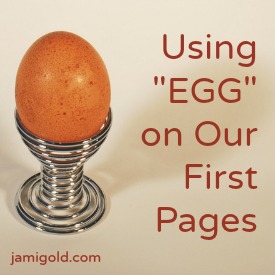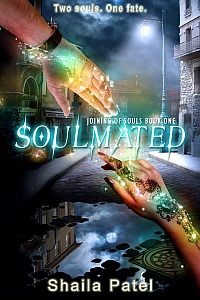No matter how much we study and try different approaches, we often struggle with our story’s first pages. We know how important it is to create a good first impression with our readers, yet there are so many elements we have to juggle that the pieces often don’t come together easily.
We might describe nail-biting action, but forget to help readers connect with the character. Or we might spend too much time in our character’s head and fail to anchor readers in the setting to give them something tangible to imagine. Etc., etc.
The ways we can screw up are almost infinite. That’s why I’m always on the lookout for new ways of thinking about that critical opening page.
Today, I’m excited to introduce Shaila Patel, who’s going to share her insights on the right mix of elements for creating a great first impression. Complete with example excerpts, she shows us how a little of this and a little of that will cook up the best opening for our story.
Please welcome Shaila Patel! *smile*
*****
An EGG for Your First Impression
It’s pretty well-established that we judge books by their covers. We all know why we shouldn’t, but let’s face it, whether we’re browsing for books at a bookstore, or surfing the Top 100 lists on Amazon, it’s the cover that catches our eye.
But that’s not really what I’ll be discussing today.
It’s about what happens after that. An interested reader will skim the back cover copy or the online description, and if they need a little something more to convince them to buy your book, they’ll read the first page. If your first page can’t convince a reader to plunk down their money, you’ve just ruined your first impression.
That’s what we’ll be talking about today: Making the perfect EGG. (No, no, not really. I just love mnemonics!)
E is for Emotions and Empathy
My debut novel, Soulmated, is a teen paranormal romance about empaths, people who can read emotions. You’d think that would help me with this, right? Well, judging by my original first chapter—not so much. (Technically it was my second chapter, but I’ll get to that later.)
If a reader can’t connect to a character, they’ll lose interest, and it won’t matter how beautiful your writing is. So how does a reader connect with a character? By empathizing with a character’s emotion. Show the reader whatever it is the character is feeling, and you’re bound to elicit some empathy.
Yes, action and plot are important, but for those few seconds where you have the reader’s undivided attention, it isn’t enough. They have to care about the character.
Let’s say you open your book with a woman baking cookies. What’s there to care about? Well, what if the woman is talking to an urn while she bakes?
Now we connect, and we’re even more curious than before.
How you elicit that emotion depends on your style, voice, and/or tone of the story—be it humorous, eerie, shocking, or engaging. Use it as a tool to appeal to the reader, giving them that dose of emotion they don’t realize they’re seeking.
That brings us back to my EGG.
G is for Grab their Attention
Some of the best story openings not only elicit some sort of empathy from the reader, but they also grab their attention with some interesting action, unexpected or intriguing dialogue or statement, or a bit of mystery—something to puzzle out.
In my cookies and urn example above, don’t spend the next 300 words reflecting on why the urn is there, or why she’s baking cookies. Jump right into the action.
Have a golf ball fly through the window and break the urn. Have the oven catch on fire. Have a living person enter the kitchen and throw a tantrum about being neglected. Have an imaginary angel come down and play tug-of-war with the urn.
See what I mean? No backstory. Get right to the action.
Based on your sub-genre, there are sure to be other ways to do this, but whichever way you draw the reader in, you have mere seconds to ensnare them. And once you do, you’ve kinda sorta made a promise that what they’re reading is what they’re going to get in the rest of the novel.
Which briiiings us back to EGG, EGG, EGG, EGG… (Sorry, had a bit of a Sound of Music moment.)
G is for Ground the Reader
Grounding a reader with regard to setting is crucial. It lets them know when and where the characters are so that your readers know what’s happening. The setting is only one part of it though.
Grounding a reader also involves style, tone, and voice. Think of it as laying the foundation of your storytelling.
If your first page (or first chapter) is hilarious, the expectation is that the rest of the book is too. If you have a snarky snap to your dialogue or voice, the reader will probably expect to hear it again. And if you write long flowing sentences that provide an escape—the rest of the book should be a ticket to your world.
This point may seem obvious to you, but believe me, when you edit your first chapter hundreds of times, it will read so much better than the rest of the book which gets less and less attention as the pages rack up. Have you ever read a review that sounds like this?
The story started out great, but I don’t know, the rest of the book just didn’t feel the same.
Not good.
It’s like those Food Court ladies giving you a sample of some tasty, perfectly cooked morsel of meat on a toothpick. If it convinces you to eat there, you certainly don’t want your meal-size portion to taste reheated, tough, and cold.
Don’t make your readers regret getting the toothpick.
Seeing it in Action
So let’s see how I used EGG on my own novel. My paranormal romance Soulmated is told in alternating points of view between my hero and heroine.
Originally, my manuscript started with my heroine’s chapter, but she’s a non-empath—which, for my paranormal story, wasn’t grounding the reader in what they could expect. So one of the first things I did was change my first chapter to my paranormal-hero’s point of view instead. (That’s why this excerpt of the original manuscript starts with Chapter 2.)
First Attempt:
CHAPTER 2 – LIAM
We parked on yet another dull street, in another dull neighborhood, of another dull city—but at least it was a new state. North Carolina.
I stepped out of Mum’s Audi and stretched. It felt good to be walking around since our last stop was back in Asheville four hours ago. We’d taken a self-guided sightseeing tour for three days, from Memphis to Cary, and if I never saw another Cracker Barrel, I’d die a happy man. Since Dad had gone on ahead to meet the movers, he’d missed all the fun.
I reached for the football I’d tossed in the boot back in Memphis and spun it on my finger. Agh, they call it a soccer ball in the States, Liam! The sounds of a lived-in neighborhood met my ears—dogs barking, lawn mowers running, and kids laughing. There were more trees around us than in our last few neighborhoods, but their thick, dark green canopies felt oppressive, nothing like the lively green from back home in Ireland.
Dad stood on the porch, rubbing his hands together, a smile glued to his face. He was always excited at the prospect of a new lead from another one of his visions.
“Isn’t this grand?” he asked. “The mountains on the drive here were fantastic, were they not?”
I rolled my eyes and bounced the football between my knees and feet.
My brother arrived minutes later, having flown into the Raleigh-Durham airport about an hour ago. Ciarán would only be staying for the weekend to help us with the unpacking. He’d be flying back home early Monday, and I’d be starting a new high school, looking for my next target. Again.
As you can see, the first version of Liam’s chapter described his reaction to moving to Cary, NC. Yawn. Well, I didn’t realize that at the time.
The only reason I changed it was because I got feedback from a prominent literary agent during a workshop, and her blunt assessment of this chapter made me cringe. She’d said: “Why would a teenaged-reader care about a boy who moved to a new town?”
Ouch.
But she was right. Liam had expressed an emotion which could have elicited some empathy from a reader, but overall, there wasn’t anything exciting about a boy moving to a new town. What’s grabbing the reader?
Would said reader be racing to the register to buy my book after reading those two hundred and eighty words? Probably not.
So I changed the beginning. Not only did I rearrange my opening chapter to Liam’s to better ground the reader, but I moved the story back six weeks to what prompted him to come to the United States in the first place—a much more exciting part.
This excerpt is only one page, but the entire first chapter addresses what the test is for, why he’s having to undergo it, and how he ends up in North Carolina—a far cry from “Woe is me, I have to move!”
So after adding a bit more EGG to my first chapter, this is how it turned out:
Final Version:
CHAPTER 1 (USED TO BE CHAPTER 2) – LIAM
They’re calling this a test?
Not even a ping grazed my mind as the five Elders tried to slip past my mental blocks and into my emotions. A sheen of sweat over William’s lip proved he wasn’t faring as well. Of all the cousins now come of age, William and I were the last to be sitting before the Elders. I’d have felt guilty for his not doing so well had he ever shown an interest in leading the family. But, we all knew he’d rather have his head in a library. Now his heart was with his wife Colleen. He at least seemed to have a choice about his fate.
I sighed. Not so for me.
“Are we boring you, Prince Liam?”
I snapped my eyes up to Elder Adebayo. He wore his trademark bow tie with a traditional fila atop his head. In the fraction of a second it took me to untangle the meaning from his heavy Nigerian accent, I’d blanked my expression and sat upright. The Elders sat along one side of an antique conference table, facing William and myself. The manor staff had rearranged the study to hold both the testing and signing-over ceremonies. Gone were the leather club chairs and stained glass lamps normally dotting the large space, giving it the air of a posh library. Now it seemed more an election night headquarters, like the sort you saw on the telly, with bright lights and a gathering of family strewn about, waiting for the results. A photographer hung about in one corner, camera in hand. Not far from him stood a team of solicitors guarding rolling briefcases that were no doubt stuffed with legal documents for the victor to sign.
My throat-clearing echoed in the now silent room, and my cheeks warmed. “No, sir, not at all. Although, uh … I’d like to know when it is you’ll begin with me.” I pasted on an oh-so innocent smirk and watched William shake his head and smother a grin. I shrugged at him, hoping to lighten the mood.
To me, this version says so much more about my character and leaves the reader with more questions than just “Yeah, so? He moved. Why should I care?”
This test Liam is taking and his reaction to it are both things to puzzle out, drawing the reader further into the chapter to have these questions answered. Aaand, now my readers know there’s something paranormal about my story right from the second sentence:
“Not even a ping grazed my mind as the five Elders tried to slip past my mental blocks and into my emotions.”
I kept these excerpts relatively short for this post, but if you’d like to read the entire first chapter of Soulmated, you can do so on Goodreads or on Amazon.
Tell me which version of Liam’s chapter you liked better and why. Then go look at your first page of your work in progress and see if you’ve started your story in the right place:
- where you can elicit some empathy,
- where you can grab a reader’s attention, and
- where you can ground your reader in the setting, tone, style, and voice of your story.
Go get some EGG on it!
*****
 As an unabashed lover of all things happily ever after, Shaila Patel’s younger self would finish reading Cinderella and fling her copy across the room because it didn’t mention what happened next. Now she writes from her home in the Carolinas and dreams up all sorts of stories with epilogues.
As an unabashed lover of all things happily ever after, Shaila Patel’s younger self would finish reading Cinderella and fling her copy across the room because it didn’t mention what happened next. Now she writes from her home in the Carolinas and dreams up all sorts of stories with epilogues.
Soulmated, her debut paranormal romance, won first place in the Young Adult category of the 2015 Chanticleer Book Reviews Paranormal Awards. A member of the Romance Writers of America, Shaila is a pharmacist by training, a medical office manager by day, and a writer by night. She enjoys traveling, craft beer, tea, and loves reading books—especially in cozy window seats. You might find her sneaking in a few paragraphs at a red light or connecting with other readers online.
Website | Facebook | Twitter | Instagram | Pinterest | Goodreads
*****
About Soulmated:
Eighteen-year-old Liam Whelan, an Irish royal empath, has been searching for his elusive soulmate. The rare union will cement his family’s standing in empath politics and afford the couple legendary powers, while also making them targets of those seeking to oust them.
Laxshmi Kapadia, an Indian-American high school student from a traditional family, faces her mother’s ultimatum: Graduate early and go to medical school, or commit to an arranged marriage.
When Liam moves next door to Laxshmi, he’s immediately and inexplicably drawn to her. In Liam, Laxshmi envisions a future with the freedom to follow her heart.
Liam’s father isn’t convinced Laxshmi is “The One” and Laxshmi’s mother won’t even let her talk to their handsome new neighbor. Will Liam and Laxshmi defy expectations and embrace a shared destiny? Or is the risk of choosing one’s own fate too great a price for the soulmated?
Amazon | B&N | Book Depository | Kobo | Google Play | Books-a-Million
*****
Thank you, Shaila! “EGG” is a fantastic way to remember to give our opening pages:
- something to connect with readers (empathy)
- something to make readers keep reading (grabbing attention)
- something to set readers’ expectations (grounding)
As Shaila said, depending on our genre and our story, we might emphasize one of those more than the others, but the best story beginnings will usually have at least some of each of those elements. We can always revise and ask for feedback to find the right mix for our story.
Depending on what kind of stories we like, some might have even liked her first example better—and that’s okay! The point is to find the first page that will best give readers the right impression for the kind of story we’re going to tell.
For Shaila’s unique story, a first page that sounded like all the other “new kid moves to town” young adult stories wouldn’t give the right impression. There are all kinds of readers and all kinds of stories, and finding the right readers for our story starts with creating the right impression with our first page. *smile*
Do you struggle with your opening pages? Have you thought about what elements you need to include on your first page? Do you know what mix of elements would work best for your story or genre? Which excerpt did you like better? Do you have any questions for Shaila?


